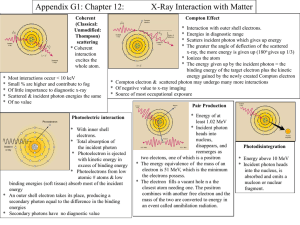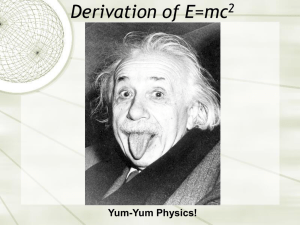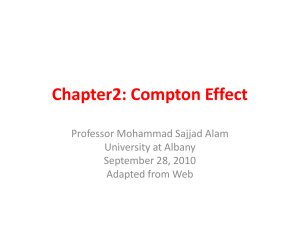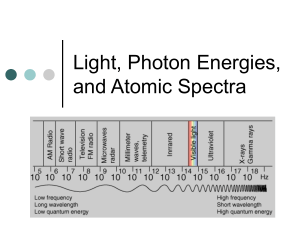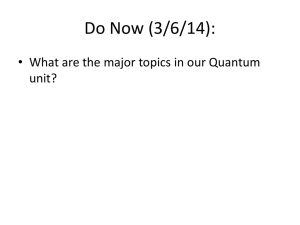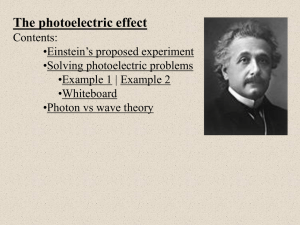The Compton Effect
advertisement
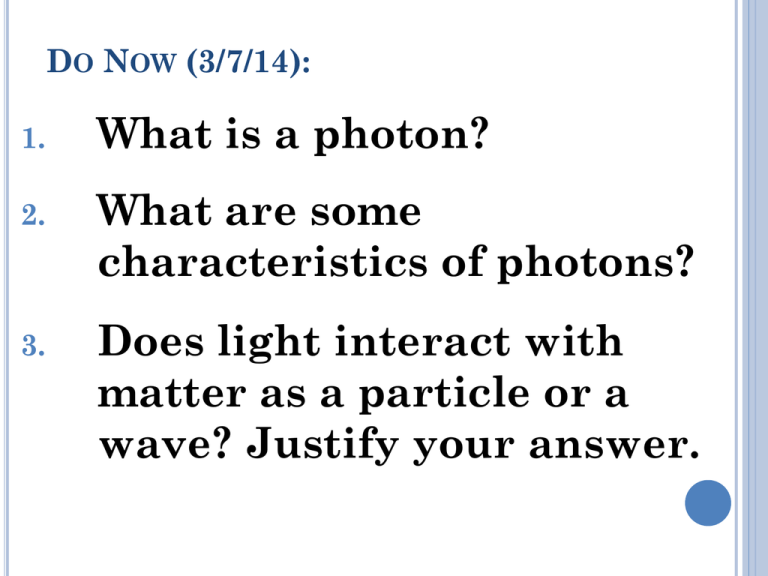
DO NOW (3/7/14): 1. What is a photon? 2. What are some characteristics of photons? 3. Does light interact with matter as a particle or a wave? Justify your answer. STRAIGHT OUTTA COMPTON THE COMPTON EFFECT 3/7/14 Pass in your DO NOWs THE COMPTON EFFECT (COMPTON SCATTERING) The Compton effect is a form of ionization. What is an ion? An ion is an electrically charged atom or group of atoms. Compton Scattering ionizes particles through the emission of an electron APPLICATION How can this be used? - Particle Accelerators - CT Scans / X-rays - Ion Propulsion Engines THE COMPTON EFFECT Result of a high-energy photon colliding with a target. THE COMPTON EFFECT (COMPTON SCATTERING) http://www.ndted.org/EducationResources/HighSchool/Radiogra phy/Graphics/Flash/compton.swf The electron is irradiated with a photon. The Scattered Photon comes off as Radiation. THE COMPTON EFFECT (COMPTON SCATTERING) This lends support to Einstein's photon theory, rather than wave theory. Compton Scattering was first demonstrated in 1923 by Arthur Holly Compton. Scattered radiation experiences a wavelength shift. X-rays increase in wavelength when scattered. How does the wave for the incident photon compare to that of the scattered photon? COMPTON SHIFT: (WRITE ON BACK) Is the change in wavelength of scattered photon h ' = (1- cos ) m0c '- = c (1- cos ) λ = incoming photon wavelength λ' = scattered photon wavelength COMPTON WAVELENGTH h C = m0c Where m0 is the mass of the target particle Example: Mr. Davis detonates an EMP weapon to destroy some robots. The bomb releases gamma rays with a wavelength of 3x10-11 m and the deflect with nitrogen and oxygen electrons at an angle of 45 degrees. What is the wavelength of the scattered gamma-rays? Volunteer for: Givens Equation ' = c (1- cos ) 3x1011m c .00243x109 m 45) '(3x1011 m) .00243x109 m(1 cos45) '(3x10 m) 7.19x10 11 -13 ' 3.07x10 m -11 CLASSWORK Two problems (9&10) require the use of photon energy, from the photoelectric effect unit, we will learn more about this next week. If you finish these problems today I will come around and give you extra credit. Spend the rest of class working on your classwork. There is a bonus assignment if you finish early. DO NOW (3/10/14) X-rays of wavelength 0.456nm are scattered from a block of carbon. What will the Compton Shift be at: a) 0˚ b) 15˚ c) 45˚ CLASSWORK At the end of class there will be a one problem Check for Understanding that is related to your Do-Now. You have all of class to ask questions. Don’t forget you can use the Parking Lot. I will put all necessary equations and variables on the board. CLASSWORK Continue working on your classwork from Friday. Questions 8,9, and 10 use energy which we will learn tomorrow. Extra Credit if you solve them today. If you finish early there is a bonus and you can start tomorrow’s classwork. Check for Understanding last 10 minutes of class. CHECK FOR UNDERSTANDING (3/10/14) X-rays of wavelength 0.789nm are scattered from a block of carbon. What is the angle of reflection of the photon if the Compton Shift is: a) 0.000326nm b) 0.001215nm c) 0.002430nm DO NOW (3/11/14) ON YOUR NOTESHEET: (5 MINUTES) A 0.123-nm photon collides with a stationary electron. After the collision, the electron moves forward and the photon recoils backwards. Do this on your notesheet but I’m going to stamp your Do Now paper. Draw a picture of the situation. 2) What is the angle between the scattered photon and the electron? 3) List three things that you have learned about that are CONSERVED. 1) GUIDED NOTESHEET Looking at the problem on the notesheet, what are we solving for? The Kinetic Energy of the Electron GUIDED NOTESHEET Lets start by looking at the motion of Wherethe does the electron electron: get the energy to start moving? When is the electron moving: Before the collision? The collision with the After Collision? photon! The electron starts out as Stationary After the collision it’s moving CONSERVATION The Is electron gains energy from it’s collision with the photon. that energy created from nothing? Where does it come from? The photon gives the electron some energy. INCIDENT PHOTON has energy E and linear momentum p: E hc E p c SCATTERED PHOTON has energy E : hc E ' THE COMPTON EFFECT The photon gives part of its energy to one of the electrons, in the form of KE Total energy and momentum must be conserved. LOSS IN PHOTON ENERGY = GAIN IN ELECTRON ENERGY KEelectron = Eincident photon – Escattered photon Equivalent notes sheet! formulas are on your EXAMPLE (5 MINUTES): a) A 70-keV photon is Comptonscattered by an electron. What is the wavelength of this initial photon? b) If the scattered photon comes off at 27, what is its wavelength after being scattered? BACK TO THE GUIDED NOTESHEET What The variables do we have so far? Initial wavelength of the photon The Angle between the photon and electron GUIDED PROBLEM We are trying to solve for the energy of the scattered electron, how does this relate the energy lost by the photon? are we solving for? LOSS What IN PHOTON ENERGY = GAIN IN ELECTRON ENERGY GUIDED PROBLEM We now need the energy of the scattered photon, what equation do we want to use? hc Knowing that Photon Energy is E transferred to the electron, what should we try to solve ' for now? To solve for the energy, what variable do we need to solve for? This means we need to solve for λ` SOLUTION (5 MINUTES) Givens: Equation: We need: Solve for λ` .123nm c .00243nm 180 ' = c (1- cos ) ` ______ Eelectron ______ ' = c (1- cos ) ' = .00243(1- cos(180)) .123 .1278nm Electron Energy: 1240 1240 E 393 eV .123 .1278 PRACTICE: Please use the rest of class to work on your classwork. It will be graded for accuracy. It Exit is due on Friday. Ticket at the end of class. EXIT TICKET (3/11/14) A 0.234-nm photon collides with a stationary electron. After the collision, the electron moves forward and the photon recoils backwards. Calculate the Kinetic Energy of the electron. CONCEPTUAL QUESTIONS (3/12/14) (5 MINUTES) In Compton Scattering 1) What happens to energy lost by the incident photon? 2) The wavelength of the scattered photon (increases/decreases) after collision with the electron. 3) What is the equation for the energy of a scattered electron? DO NOW (3/12/14) (8 MINUTES) 1) What is the equation for the energy of a scattered electron? 2) A 0.234-nm photon collides with a stationary electron. After the collision, the electron moves forward and the photon recoils backwards. a) Calculate the wavelength of the scattered photon. b) Calculate the Kinetic Energy of the electron. 108 eV GROUP QUIZ REVIEW I’m going to check one paper per group. Competition First for Quiz Extra Credit Three groups to finish the worksheet with every problem correct get Extra Credit GROUP QUIZ REVIEW When you finish a page raise your hand and I will come check it. If you get stuck, skip that problem and come back to it later. PERIOD 4 Cortney Stephanie Ambe Emilie Shazaad Maria Rakem Imani Alexis India H Myeasher Tyler Briahna Chalet Ayona Jade Ayanna Alex Heaven Jasir Corey Jasmine India C Shaitia Emmeranda Ciairah Johnelle PERIOD 6 Sade` Brianna Brooke Imani Vaughn Maria Morgan Uyen Charles Kate Kendall Teira Shaolin Tristan Kayla Tariq Kareem De’Aira Shania Chelsey Justin PERIOD 7 Denise Ayana Mariah Sharae Maullea Jermira Jaleel Leez Alvin Ti-Taiyonna Shamar Chance Daja Will H Ta’es Kyallah Katesha Rubi Courtnei Will D Tatiana Malcolm Michael Shem Leon Camille Stephanie Quinones GROUP QUIZ REVIEW When you finish a page raise your hand and I will come check it. If you get stuck skip that problem and come back to it later. I’m going to check one paper per group, so make sure one paper has all the solutions. COMPTON SHIFT: The change in wavelength of scattered photon h ' = (1- cos ) m0c '- = c (1- cos ) THE COMPTON EFFECT Do Now (3/13/12): Photons are released with a -11 wavelength of 4.7x10 m and they deflect with nitrogen and oxygen electrons at an angle of 60 degrees. What is the wavelength of the scattered gamma-rays? EXAMPLE: A 70-keV photon is Compton-scattered by an electron. If the scattered photon comes off at 27, what is its wavelength? DO NOW (3/14/12): A 60 keV photon is Compton-scattered by an electron. If the scattered photon comes off at 36, what is its wavelength? EXAMPLE: A 210-nm photon collides with a stationary electron. After the collision, the electron moves forward and the photon recoils backwards. Calculate the kinetic energy of the electron. DO NOW (3/15/12): A 0.23-nm photon collides with a stationary electron. After the collision, the electron moves forward and the photon recoils backwards. Calculate the kinetic energy of the electron. EXIT TICKET (3/10/14) A 0.045-nm x-ray is scattered through an angle of 30º. What is the frequency of the scattered x-ray?


